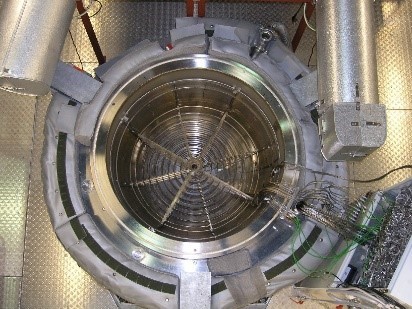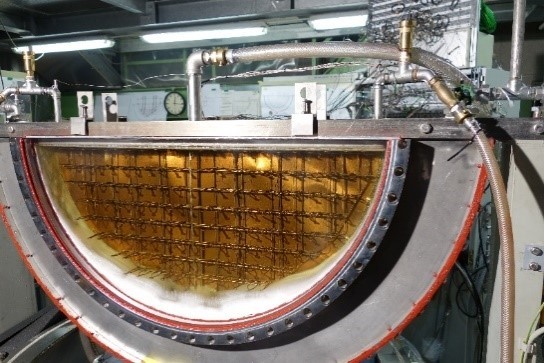LIVE3D and LIVE2D Experimental Program
The LIVE3D and LIVE2D test facilities simulate the lower plenum of a water-cooled reactor pressure vessel and investigate the transient and steady state thermos-hydraulic and heat transfer of solid and liquid corium under various accident scenarios. The two facilities are in the same scale and with the same heating and cooling concept, but in different geometries. The LIVE3D facility is a semi-spherical lower head, whereas LIVE2D vessel is a semi-circular slice.
The main part of the LIVE-3D test facility is a 1:5 scaled lower head of the typical pressurized water reactor. The vessel inner diameter is 1 m. The LIVE-2D slice vessel has a width of 12 cm and also a diameter of 1 m. The backside of the LIVE2D test vessel is insulated, the curved sidewall is water cooled, and the front side consists of two quartz plates with limited heat loss. The transparent front wall is a pioneer in it´s kind, which enable the direct visualization of a range of phenomena in a melt pool. The maximum volumetric heating power is 28 kW and 16 kW for LIVE3D and for LIVE2D resectively.
Both facilities share the same melt preparation. The volumetric decay heat in corium is simulated with several planes of individually controllable electrical resistance heating elements. An outer cooling vessel enclosing the test vessel enable the external flooding of the test vessel with water. Top surface can be either insulated or cooled. Top-cooling is realized with a water-cooled lid located on the melt surface. The total flow rate of the cooling water is up to 1.3 L/s. Extensive temperature measurement in the bulk melt, in the boundary layer and at the vessel wall enable the temperature screening in the bulk, determination of crust change on the boundary and heat flux distribution on the vessel wall LIVE3D vessel LIVE2D vessel.


| LIVE3D vessel | LIVE2D vessel |
One purpose of the two facilities is to investigate the influence of the geometry on the thermo-hydraulic and heat transfer at the top and wall boundary. Due to the different sidewall to the top surface area ratio between the two geometries, the relation of the heat transpfer rate at top surface to the wall boundary is shifted. This effect influence in return turbulent pattern, temperature distribution and heat flux distribution {Gaus-Liu, 2019 #215}. A special purpose of LIVE2D facility is the direct observation of the turbulent pattern and the crust change of a stratified melt pool which has a high tendency on the heat flux focusing effect in the upper layer {Gaus-Liu, 2020 #984}
Simulant materials
- Oxide liquid melt: eutectic KNO3-NaNO3 mixture with melting point at 222° C; non-eutectic mixture of 20 mol. % NaNO3 – 80 mol. % KNO3 with liquidus temperature at 285° C; Water
- Liquid metal in a stratified pool: a thermal oil with the operational temperature up to 240° C
- Debris: nitrate particles, granite particles and ZrO2 rich ceramic beads
Publications
Gaus-Liu, X., Cron, T., Fluhrer, B., & Wenz, T. (2021). Experimental study and analytical analysis on the global heat transfer of stratified corium in LWR lower head. Nuclear Engineering and Design, 372, 110999. doi:https://doi.org/10.1016/j.nucengdes.2020.110999
Gaus-Liu, X. (2019). Impact of vessel geometry and boundary condition on the heat transfer of liquid corium in LWR lower head. Paper presented at the 27th International Conference on Nuclear Engineering: Nuclear Power Saves the World!, ICONE 2019; Tsukuba International Congress CenterTsukuba, Ibaraki; Japan; 19 May 2019 through 24 May 201.
Gaus-Liu, X., Cron, T., & Fluhrer, B. (2020). Experimental Studies on Two-Layer Corium Heat Transfer in Light Water Reactor Lower Head in LIVE2D Facility. Nuclear Technology, 1-12. doi:10.1080/00295450.2020.1743102
Gaus-Liu, X., Miassoedov, A., Foit, J., Cron, T., Kretzschmar, F., Palagin, A., . . . Schmidt-Stiefel, S. (2013). LIVE-L4 and LIVE-L5L experiments on melt pool and crust behavior in lower head of reactor pressure vessel. Nuclear Technology, 181, 216-226.
Miassoedov, A., Gaus-Liu, X., & Cron, T. (2016). Study of melt formation and behavior of a two-component debris bed in LIVE facility. Transactions of the American Nuclear Society, 115, 865-868.
Seiler, J. M., Ratel, G., Combeau, H., Gaus-Liu, X., Kretzschmar, F., & Miassoedov, A. (2014). Transient refractory material dissolution by a volumetrically-heated melt. Nuclear Engineering and Design, 280, 420-428. doi:10.1016/j.nucengdes.2014.09.025
